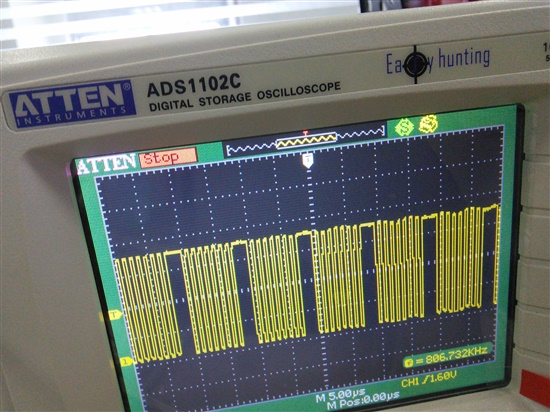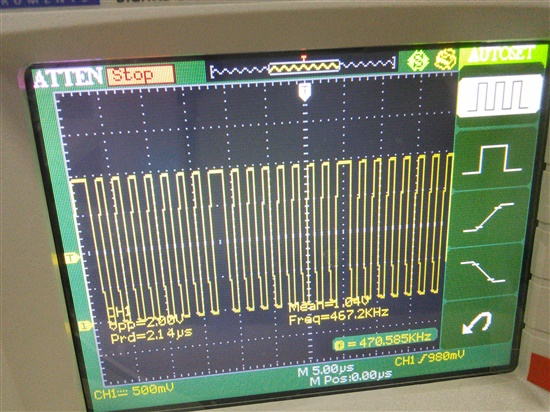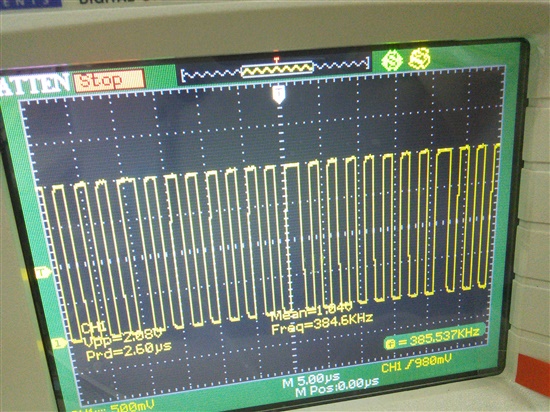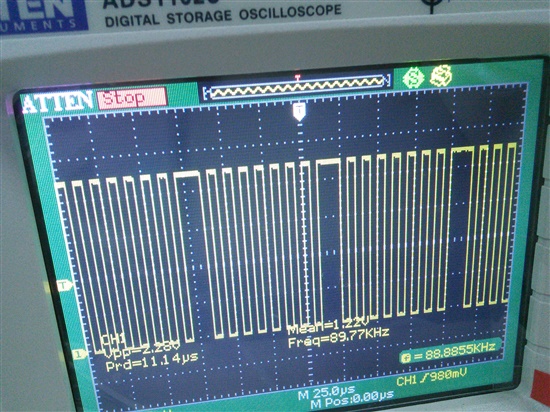请教TI工程师,
目前我在做的案子(24MH晶振,SMCLK和MCLK都选择24M频率),目前需要3MHz的频率;想通过配置USCI_B1配置成SPI master mode来产生一个3M的频率!
然后,现在打算参考ccs 中产生SPI的程序。
但是调试,CCS给的SPI例程发现,SPI产的波形并不是持续的时钟,而是断续的时钟:SPI是否可以产生持续的时钟
如下图所示:用示波器查看P4.3脚 CLK
// MSP430F552x// ----------------- // /|\| | // | | | // --|RST P1.0|-> LED // | | // | P3.4|-> Data Out (UCA0SIMO) // | | // | P3.5|<- Data In (UCA0SOMI) // | | // Slave reset <-|P1.1 P3.0|-> Serial Clock Out (UCA0CLK) // // // Bhargavi Nisarga // Texas Instruments Inc. // April 2009 // Built with CCSv4 and IAR Embedded Workbench Version: 4.21 //****************************************************************************** #include <msp430.h> unsigned char MST_Data,SLV_Data; unsigned char temp; int main(void) { volatile unsigned int i; WDTCTL = WDTPW+WDTHOLD; // Stop watchdog timer P1OUT |= 0x02; // Set P1.0 for LED /* // Set P1.1 for slave reset P1DIR |= 0x03; // Set P1.0-2 to output direction P3SEL |= BIT3+BIT4; // P3.3,4 option select P2SEL |= BIT7; // P2.7 option select UCA0CTL1 |= UCSWRST; // **Put state machine in reset** UCA0CTL0 |= UCMST+UCSYNC+UCCKPL+UCMSB; // 3-pin, 8-bit SPI master // Clock polarity high, MSB UCA0CTL1 |= UCSSEL_2; // SMCLK UCA0BR0 = 0x02; // /2 UCA0BR1 = 0; // UCA0MCTL = 0; // No modulation UCA0CTL1 &= ~UCSWRST; // **Initialize USCI state machine** UCA0IE |= UCRXIE; // Enable USCI_A0 RX interrupt P1OUT &= ~0x02; // Now with SPI signals initialized, P1OUT |= 0x02; // reset slave for(i=50;i>0;i--); // Wait for slave to initialize MST_Data = 0x01; // Initialize data values SLV_Data = 0x00; // while (!(UCA0IFG&UCTXIFG)); // USCI_A0 TX buffer ready? UCA0TXBUF = MST_Data; // Transmit first character */ ///// P1DIR |= 0x03; // Set P1.0-2 to output direction P4SEL |= BIT1+BIT2+BIT3; // P3.3,4 option select // P4DIR |= BIT3; // P2.7 option select UCB1CTL1 |= UCSWRST; // **Put state machine in reset** UCB1CTL0 |= UCMST+UCSYNC+UCCKPL+UCMSB; // 3-pin, 8-bit SPI master // Clock polarity high, MSB UCB1CTL1 |= UCSSEL_2; // SMCLK UCB1BR0 = 0x02; // /2 UCB1BR1 = 0; // //UCBxMCTL = 0; // No modulation UCB1CTL1 &= ~UCSWRST; // **Initialize USCI state machine** UCB1IE |= UCRXIE; // Enable USCI_A0 RX interrupt P1OUT &= ~0x02; // Now with SPI signals initialized, P1OUT |= 0x02; // reset slave for(i=50;i>0;i--); // Wait for slave to initialize MST_Data = 0x01; // Initialize data values SLV_Data = 0x00; // while (!(UCB1IFG&UCTXIFG)); // USCI_A0 TX buffer ready? UCB1TXBUF = MST_Data; // Transmit first character /////////////////////////////////////////////////////////////////////////////////////// __bis_SR_register(LPM0_bits + GIE); // CPU off, enable interrupts while(1); } //////////////////////////////////////////////////////////////////// #pragma vector=USCI_B1_VECTOR __interrupt void USCI_B1_ISR(void) { volatile unsigned int i; switch(__even_in_range(UCB1IV,4)) { case 0: break; // Vector 0 - no interrupt case 2: // Vector 2 - RXIFG while (!(UCB1IFG&UCTXIFG)); // USCI_A0 TX buffer ready? if (UCB1RXBUF==SLV_Data) // Test for correct character RX'd P1OUT |= 0x01; // If correct, light LED else P1OUT &= ~0x01; // If incorrect, clear LED MST_Data++; // Increment data SLV_Data++; UCB1TXBUF = MST_Data; // Send next value for(i = 20; i>0; i--); // Add time between transmissions to // make sure slave can process information break; case 4: break; // Vector 4 - TXIFG default: break; } } //////////////////////////////////////////////////////////////////// /* #pragma vector=USCI_A0_VECTOR __interrupt void USCI_A0_ISR(void) { volatile unsigned int i; switch(__even_in_range(UCA0IV,4)) { case 0: break; // Vector 0 - no interrupt case 2: // Vector 2 - RXIFG while (!(UCA0IFG&UCTXIFG)); // USCI_A0 TX buffer ready? if (UCA0RXBUF==SLV_Data) // Test for correct character RX'd P1OUT |= 0x01; // If correct, light LED else P1OUT &= ~0x01; // If incorrect, clear LED MST_Data++; // Increment data SLV_Data++; UCA0TXBUF = MST_Data; // Send next value for(i = 20; i>0; i--); // Add time between transmissions to // make sure slave can process information break; case 4: break; // Vector 4 - TXIFG default: break; } } */




